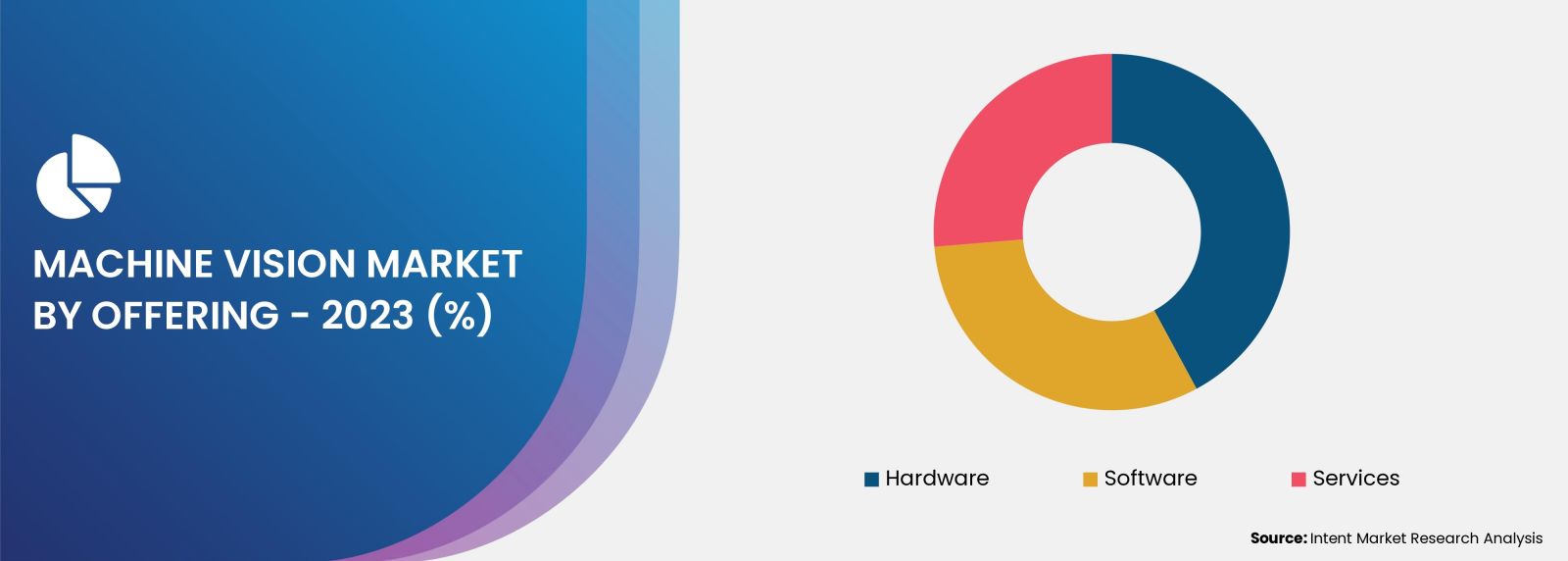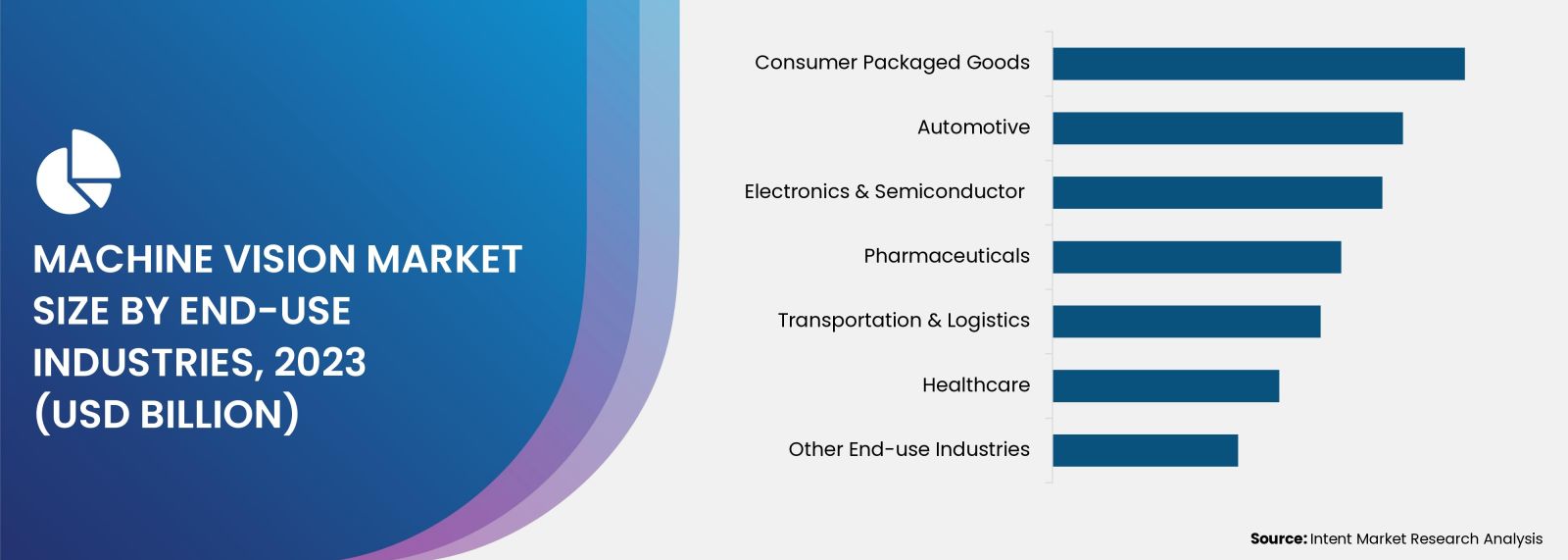According to Intent Market Research, the Machine Vision Market is expected to grow from USD 14.1 billion in 2023-e at a CAGR of 9.2% to touch USD 26.1 billion by 2030. The machine vision market is a competitive market, the prominent players in the global market include Bosch, Cognex, HIK Robot, Intel, Keyence, Omron, Sick, Tamron, Texas Instruments, and Zebra, among others.

Greater emphasis on quality is driving the machine vision market
Machine vision is the technology that enables machine or robots to replicate human vision capabilities and recognize objects in their vicinity. This ability of machine helps in inspection, detection and guiding. With the greater emphasis on quality improvement across industries, the demand for machine vision is growing in the recent past. However, lack of skilled workforce is restraining the market growth.
Machine vision technology offers several growth opportunities to the market stakeholders. For instance, in automotive industry, autonomous driving can be possible with the integration of machine vision technology in vehicles. However, high cost of system associated with this advanced technology is expected to be the major challenge for the market growth.
Growing investment in automation is driving the machine vision market
Automation offers benefits such as increased efficiency, cost reduction, enhanced productivity, quality improvement, reduction in downtime, etc. With the implementation of automation like machine vision, a production unit is able to increase its output, reduce labour cost, and faster time-to-market. This in turn helps to improve the revenues for the company. This has largely influenced the market stakeholders to invest in automation. For instance, in November 2023, SiLC Technologies (US) has secured USD 25 million in additional funding to expand its machine vision for AI related applications such as mobility, robotics, smart cameras, security, etc.
Machine Vision market segment insights
High Demand for Smart Cameras is Driving the Hardware Segment Growth
Based on offering, the machine vision market is segmented as hardware, software and services. In 2023, the hardware segment is anticipated to account for the significant market share. The growing demand for smart cameras, and sensors, used in automating the production line is driving the hardware segment growth.

High demand from end-use industries driving the demand for 2D machine vision system
The 2D type of machine vision system is anticipated to account for a significant market share in 2030. 2D machine vision system offers several applications in the end-use industries such as PCB inspection in semiconductor industry, document verification in BFSI & banking industry, packaging inspection in pharmaceuticals and food & beverage industry and defect detection in automotive industry. Rising demand from end-use industries is projected to fuel the segment growth over the forecast period.
Application in autonomous vehicles expected to increase the demand for guidance & positioning
Machine vision offers several industrial applications such as inspection & detection, guidance & positioning, identification, etc. With the growing investment in R&D of autonomous vehicle driving, the guidance & positioning segment is expected to record significant growth during the forecast period. For autonomous vehicles, precise navigation and obstacle detection is the most crucial for safe travel. Major automotive companies such as Tesla, Volkswagen, Uber, etc. are already investing in autonomous driving that can provide level 4 and level 5 types of vehicle autonomy.
High penetration of automation consumer packaged goods industry is driving machine vision market growth
Machine vision technology is applicable across different industries such as automotive, consumer packaged goods (CPG), electronics & semiconductors, healthcare, pharmaceuticals, and transportation & logistics, among others. CPG industry has largely invested in automating its functions such as production line, packaging & labelling, and robotics. With the growing penetration of automation in CPG industry, it is expected to drive segment growth over the forecast period.

Greater emphasis on automation by governments pushing the Asia-Pacific market on the strong growth path
In Asia-Pacific, there is significant investment in automation of industries. Regional countries are pushing for automation and robotics in the manufacturing industries. China is the leading player in the regional market and in 2022, the China’s government released its five-year plan to become a global leader in industrial automation. The country achieved 44% Y-o-Y growth in terms of robots installations in 2021.
Major industry players are enhancing their market positions by adopting several growth strategies
Major players operating in the global machine vision market are Bosch, Cognex, HIK Robot, Intel, Keyence, Omron, Sick, Tamron, Texas Instruments, and Zebra, among others. In addition, there are several prominent start-ups working in the market among them Aeye, Aibee, Algolux, Clarifai, Cogniac, Deepomatic, PerceptIn, Taranis, Traptic and Veo Robotics are the leading start-ups operating in the market.
Presence of several players have significantly fragmented the market. To tap the potential share of the market, major players have started adopting strategies such as new product launch, merger & acquisition, partnership & collaboration, etc. Some of the significant developments are mentioned below
- In November 2023, Zebra announced that the Bosch is improving the quality of its inspection process and achieving higher production volumes using Zebra’s machine vision solutions to enhance operational visibility and quality inspections.
- In September 2023, Cognex launched its In-Sight SnAPP vision sensor. It offers ease of use, accuracy, and functionality in an industrial sensor.
Machine Vision Market Coverage
The report provides key insights into the machine vision market, and it focuses on technological developments, trends, and initiatives taken by the government and private players. It delves into market drivers, restraints, opportunities, and challenges that are impacting the market growth. It analyses key players as well as the competitive landscape within the global market.

Report Scope:
|
Report Features |
Description |
|
Market Size (2023-e) |
USD 14.1 billion |
|
Forecast Revenue (2030) |
USD 26.1 billion |
|
CAGR (2024-2030) |
9.2% |
|
Base Year for Estimation |
2023-e |
|
Historic Year |
2022 |
|
Forecast Period |
2024-2030 |
|
Report Coverage |
Market Forecast, Market Dynamics, Competitive Landscape, Recent Developments |
|
Segments Covered |
By Type (1D, 2D, 3D); By Offering (Hardware(Sensor, Camera, Vision Controller, Frame Grabber, Others), Software (Barcode Reading Software, Deep Learning Software, Others (Design S/W, Tools, etc.)), Services (System Integration, System Management)); By Application (Inspection & Detection, Guidance & Positioning, Identification); By Platform (PC-based, Camera-based); By End-use Industry (Automotive, Consumer Packaged Goods, Electronics & Semiconductor, Healthcare, Pharmaceutical, Food & Beverages, Transportation & Logistics) |
|
Regional Analysis |
North America (US, Canada), Europe (Germany, France, UK, Italy), Asia-Pacific (China, Japan, South Korea, India), Latin America and Middle East & Africa |
|
Competitive Landscape |
Bosch, Cognex, HIK Robot, Intel, Keyence, Omron, Sick, Tamron, Texas Instruments, and Zebra |
|
Customization Scope |
Customization for segments, region/country-level will be provided. Moreover, additional customization can be done based on the requirements. |
|
Purchase Options |
We have three licenses to opt for Single User License, Multi-User License (Up to 5 Users), Corporate Use License (Unlimited User and Printable PDF) |
|
1.Introduction |
|
1.1.Market Definition |
|
1.2.Scope of the Study |
|
1.3.Key Stakeholders of the Market |
|
2.Research Methodology |
|
2.1.Research Approach |
|
2.2.Data Collection |
|
2.3.Market Assessment |
|
2.4.Assumptions & Limitations for the Study |
|
3.Executive Summary |
|
4.Market Dynamics |
|
4.1.Drivers |
|
4.1.1.Greater Emphasis on Quality |
|
4.1.2.Growing Focus on Industrial Automation & Robotics, and Industry 4.0 |
|
4.2.Restraints |
|
4.2.1.Lack of Skilled Workforce |
|
4.2.2.Vulnerability to Cyber-attacks |
|
4.3.Opportunities |
|
4.3.1.Opportunities in various End-use Industry |
|
4.3.1.1.Automotive: Autonomous Driving |
|
4.3.1.2.Packaging: Pallet Dimensioning |
|
4.4.Challenges |
|
4.4.1.Integration of Advanced Technologies in Traditional Production Line |
|
4.4.2.High Cost of AI-based Machine Vision System |
|
4.5.Trends |
|
4.5.1.Synergy Between 5G and Machine Vision |
|
4.5.2.Hyperspectral Imaging Enables Improved Machine Vision |
|
5.Market Outlook |
|
5.1.Pricing Analysis |
|
5.2.PORTER’S Five Forces Analysis |
|
5.3.PESTLE Analysis |
|
5.4.Case Studies |
|
6.Market Size by Type (Market Size & Forecast: USD Billion, 2023 – 2030) |
|
6.1.1D (Line Scan) |
|
6.2.2D (Area Scan) |
|
6.3.3D |
|
7.Market Size by Offering (Market Size & Forecast: USD Billion, 2023 – 2030) |
|
7.1.Hardware |
|
7.1.1.Sensor |
|
7.1.2.Camera |
|
7.1.3.Vision Controller |
|
7.1.4.Frame Grabber |
|
7.1.5.Others |
|
7.2.Software |
|
7.2.1.Barcode Reading Software |
|
7.2.2.Deep Learning Software |
|
7.2.3.Others |
|
7.3.Services |
|
7.3.1.System Integration |
|
7.3.2.System Management |
|
8.Market Size by Platform (Market Size & Forecast: USD Billion, 2023 – 2030) |
|
8.1.PC-based |
|
8.2.Camera-based |
|
9.Market Size by Application (Market Size & Forecast: USD Billion, 2023 – 2030) |
|
9.1.Inspection & Detection |
|
9.2.Guidance & Positioning |
|
9.3.Identification |
|
9.4.Others |
|
10.Market Size by End-use Industry (Market Size & Forecast: USD Billion, 2023 – 2030) |
|
10.1. Automotive |
|
10.2. Consumer Packaged Goods |
|
10.3. Electronics & Semiconductor |
|
10.4. Healthcare |
|
10.5. Pharmaceuticals |
|
10.6. Transportation & Logistics |
|
10.7. Others |
|
11.Regional Outlook, (Market Size & Forecast: USD Billion, 2023 – 2030) |
|
11.1. North America |
|
11.1.1. US |
|
11.1.1.1. US Market Outlook by Type |
|
11.1.1.2. US Market Outlook by Offering |
|
11.1.1.3. US Market Outlook by Platform |
|
11.1.1.4. US Market Outlook by Application |
|
11.1.1.5. US Market Outlook by End-use Industry |
|
Note: Similar Cross-segmentation for each country will be covered as shown above |
|
11.1.2. Canada |
|
11.2. Asia-Pacific |
|
11.2.1. China |
|
11.2.2. Japan |
|
11.2.3. South Korea |
|
11.2.4. India |
|
11.3. Europe |
|
11.3.1. U.K. |
|
11.3.2. Germany |
|
11.3.3. France |
|
11.3.4. Italy |
|
11.4. Latin America |
|
11.5. Middle East & Africa |
|
12.Competitive Landscape |
|
12.1. Market Share Analysis |
|
12.2. Key Market Growth Strategies |
|
12.3. Company Strategy Analysis |
|
12.4. Competitive Benchmarking |
|
13.Company Profile |
|
13.1. Bosch |
|
13.2. Cognex |
|
13.3. HIK Robot |
|
13.4. Intel |
|
13.5. Keyence |
|
13.6. Omron |
|
13.7. Sick |
|
13.8. Tamron |
|
13.9. Texas Instruments |
|
13.10. Zebra |
|
14.Start-up Analysis |
|
14.1. Aeye |
|
14.2. Aibee |
|
14.3. Algolux |
|
14.4. Clarifai |
|
14.5. Cogniac Corporation |
|
14.6. Deepomatic |
|
14.7. PerceptIn |
|
14.8. Taranis |
|
14.9. Traptic |
|
14.10. Veo Robotics |
|
15.Appendix |
Intent Market Research employs a rigorous methodology to minimize residual errors by carefully defining the scope, validating findings through primary research, and consistently updating our in-house database. This dynamic approach allows us to capture ongoing market fluctuations and adapt to evolving market uncertainties.
The research factors used in our methodology vary depending on the specific market being analysed. To begin with, we incorporate both demand and supply side information into our model to identify and address market gaps. Additionally, we also employ approaches such as Macro-indicator Analysis, Factor Analysis, Value Chain-based Sizing, and forecasting to further increase the accuracy of the numbers and validate the findings.
Research Approach

- Secondary Research Approach: During the initial phase of the research process, we acquire and accumulate extensive data continuously. This data is carefully filtered and validated through a variety of secondary sources.
- Primary Research Approach: Following the consolidation of data gathered through secondary research, we initiate a validation process to verify all the market numbers, assumptions and validate the findings by engaging with subject matter experts.
Data Collection, Analysis and Interpretation:

Research Methodology
Our market research methodology utilizes both top-down and bottom-up approaches to segment and estimate quantitative aspects of the market. We also employ multi-perspective analysis, examining the market from distinct viewpoints.


